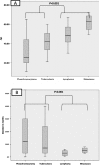Bilateral adrenal masses: a single-centre experience
- PMID: 27037294
- PMCID: PMC5002952
- DOI: 10.1530/EC-16-0015
Bilateral adrenal masses: a single-centre experience
Abstract
Background: Bilateral adrenal masses may have aetiologies like hyperplasia and infiltrative lesions, besides tumours. Hyperplastic and infiltrative lesions may have coexisting hypocortisolism. Bilateral tumours are likely to have hereditary/syndromic associations. The data on clinical profile of bilateral adrenal masses are limited.
Aims: To analyse clinical, biochemical and radiological features, and management outcomes in patients with bilateral adrenal masses.
Methods: Retrospective analysis of 70 patients with bilateral adrenal masses presenting to a single tertiary care endocrine centre from western India (2002-2015).
Results: The most common aetiology was pheochromocytoma (40%), followed by tuberculosis (27.1%), primary adrenal lymphoma (PAL) (10%), metastases (5.7%), non-functioning adenomas (4.3%), primary bilateral macronodular adrenal hyperplasia (4.3%), and others (8.6%). Age at presentation was less in patients with pheochromocytoma (33 years) and tuberculosis (41 years) compared with PAL (48 years) and metastases (61 years) (P<0.001). The presenting symptoms for pheochromocytoma were hyperadrenergic spells (54%) and abdominal pain (29%), whereas tuberculosis presented with adrenal insufficiency (AI) (95%). The presenting symptoms for PAL were AI (57%) and abdominal pain (43%), whereas all cases of metastasis had abdominal pain. Mean size of adrenal masses was the largest in lymphoma (5.5cm) followed by pheochromocytoma (4.8cm), metastasis (4cm) and tuberculosis (2.1cm) (P<0.001). Biochemically, most patients with pheochromocytoma (92.8%) had catecholamine excess. Hypocortisolism was common in tuberculosis (100%) and PAL (71.4%) and absent with metastases (P<0.001).
Conclusion: In evaluation of bilateral adrenal masses, age at presentation, presenting symptoms, lesion size, and biochemical features are helpful in delineating varied underlying aetiologies.
Keywords: adrenal; endocrine cancers.
© 2016 The authors.
Figures



References
-
- Kloos RT, Gross MD, Francis IR, Korobkin M, Shapiro BS. Incidentally discovered adrenal masses. Endocrine Reviews 1995. 16 460–484. - PubMed
-
- Mundada OP, Aron M, Sivaramakrishna B, Gupta NP. Bilateral adrenal metastases from a primary hepatocellular carcinoma. International Urology and Nephrology 2003. 35 303–305. - PubMed
LinkOut - more resources
Full Text Sources
Other Literature Sources

